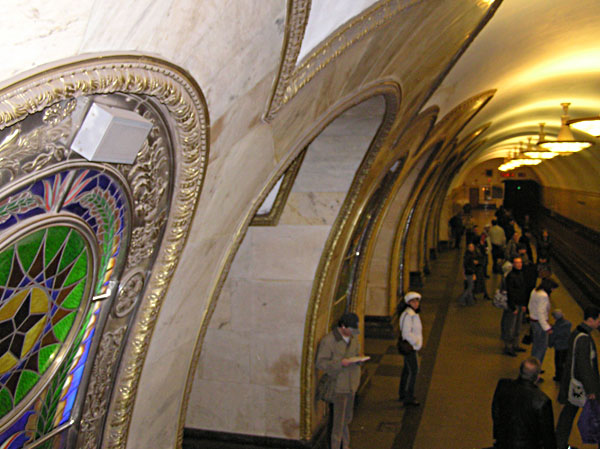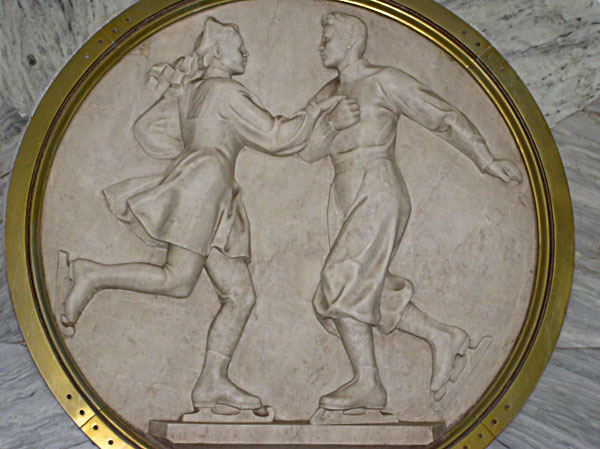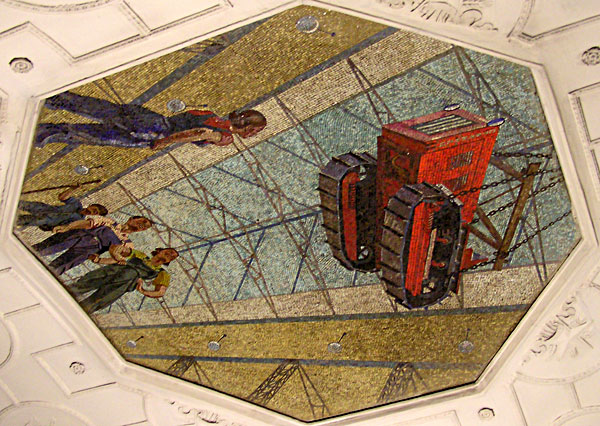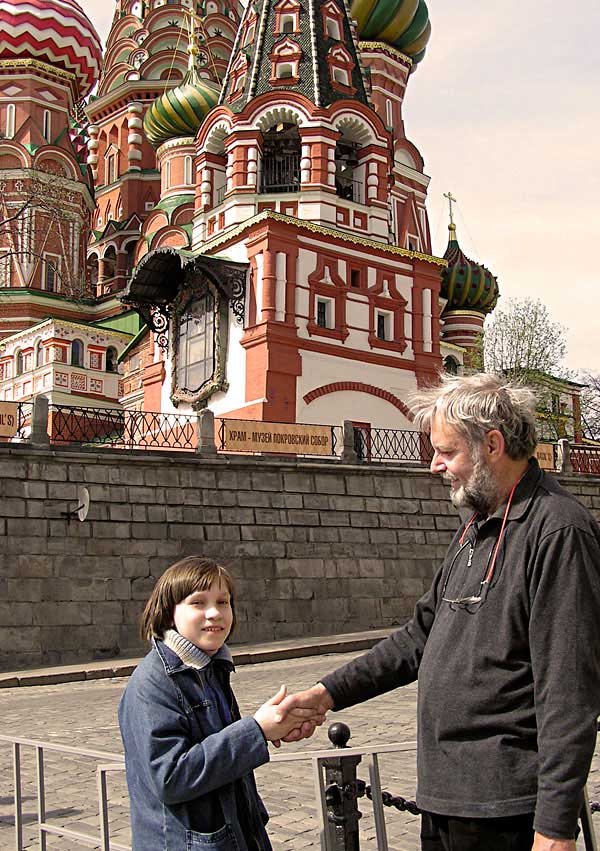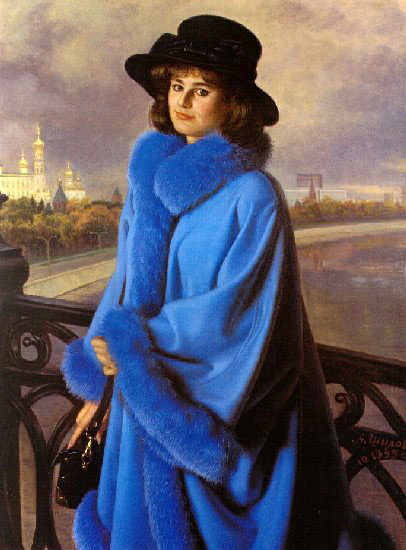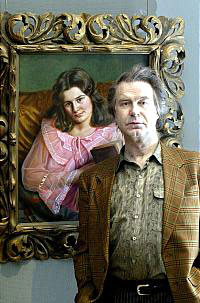Dear Artist,
It’s the world’s largest and cheapest art gallery. Every day more than 8 million people take a ride on The Moscow “Metro” Underground. In rush hours the trains arrive every 50 seconds. For a dollar or less you can go all day. On speedy escalators you plunge down deeply into the most magnificent “People’s Palaces.” By jumping in and out of trains you can see most of the best stations in several hours. The Russian (Cyrillic) direction signs are a bit of a challenge. And the unsmiling and often sleeping attendants won’t help you. We figured out the underground by memorizing the first three characters of each station.
Each station is arrestingly different — having the unique touch of differing architects, artists and artist-committees. The festive-looking halls and vestibules, some of them dating from the thirties, are decorated with sculpture, bas-reliefs, mosaics, paintings, stained glass and murals. More than 20 varieties of marble and other rare stones were brought from all parts of Russia. In their time the stations won international awards for urban design. Later, they were to do double service as bomb shelters. To get an idea of Moscow underground art I’ve asked Andrew to include some of my shots below.
Muscovites are a preoccupied and hurried bunch. Flowing like cream from one train to the next, they barely give the Peoples’ Art a glance. A photographing goon among the crowd is regarded as a nuisance. The newer stations are more simple and austere. I’m told this is because of the current hard-times. I don’t think so. Public art takes vision. Russia is in the midst of re-inventing itself and there’s not quite the vision. In the meantime mosaics that show joyous workers hoisting tractors from an assembly line — or ceramic bas-reliefs of broad-bosomed country girls reaping wheat for the state — are suspect. For a while the citizens of Russia saw the future, but after a while they saw that it didn’t work all that well. Right now they need individualist art of similar quality that tells of the wider family of man and the preciousness of freedom. In the meantime this underground vision lives in its variety, earnestness, and state optimism. Quite a bit of Soviet art has recently been effaced or taken down. Let us hope that the powers that be see fit to leave the Metro be — and add to it.
Best regards,
Robert
PS: “For art to nourish the roots of culture, society must set the artist free to follow his vision wherever it takes him.” (John F. Kennedy)
Esoterica: The artists that I’m talking to are conservative-minded and often bitter about their current economy. Many have also concluded that the “Modernist” West has gone off the rails. Having lived with the tradition that vision can be dictated from above, there is also the rustle of philosophic and humanistic creativity that has always been at the core of Russian art. While some idealism seems to have been knocked out of creators — I see the spirit as pretty hard to kill. Russian art training and skills are legendary. It’s just a matter of time.
The Moscow Metro Underground
Corrections to Moscow observations
by Andrei Sobolevskii, Moscow, Russia
Nice to know you are (or just have been) in my city. Thanks a lot for your letters; I’m not a painter, but they often contain useful things no matter what is your profession (I’m a physicist and a university teacher), so I’m one of your eager twice weekly readers.
Thanks for your nice observations on the Moscow metro, too. You are lucky with “Kro”: until a couple of weeks ago (literally), it has been dim and gloomy, and the present, just installed lighting gives it a look that the architect (Dushkin) must have been dreaming of. There are two very slight inaccuracies in what you write though: The most simplistic of the new stations date 25-30 years back, so their primitive nature is due to poor taste of decision makers of the time, not to the present economic difficulties. Also, I don’t remember any Soviet decoration removed during the 1990s, although Khrushchev did remove a lot of Stalinist decorations in the early 1960s. You might have seen the mosaic picture of Gagarin at the Dobryninskaya Station, which replaced a much nicer portrait of Stalin. This said, thanks again!
Of frozen noses and vodka
by Janet Badger, Austin, TX, USA
I lived in Russia for three years — 1996, 1997, 1998. My etchings went gray and muted in Moscow; the spring was too short to stay with me, and the long, long winter a constant challenge. I remember emerging from the Begovaya Metro on Easter Sunday to have my nose (the only uncovered part of my anatomy) immediately covered with snow, like a sno-cone! It was so ridiculous I had to laugh!
It was my privilege to work for a time at Studio Nivinskovo, among some of the talented etchers of Moscow. Though I studied the language intensively, I could only understand a word here and there… a few corks bobbing on the sea of Russian washing past me. But I heard the English translation in my head the day Sergei looked at yet another of my prints and said, “Why don’t you take those plastic gloves off and Wipe the Plate with Your Hand the way you are supposed to!” The next print I got my hands good and black, but I got a good print… and cried on Sergei’s shoulder, mourning a decade of prints that might have been better.
4 p.m. in the studio was tea time, and we’d gather and share what snacks we had, and drink tea. Every so often someone would bring out a bottle of vodka instead. I remember asking Vladimir, “What’s the holiday?” His answer: “It’s Wednesday!” Worked for me… no problem enjoying vodka now and then, with the Metro just around the corner. I was more free in Moscow than I am here — “fear of freeways.”
I never met a Russian I didn’t like. They are a warm and wonderful people. They want what we all want: a living wage, a future for their children. I left part of myself in Moscow, and took away memories of the experience of a lifetime. And by the way, we came away believing vodka should be icy cold… we keep ours in the freezer!
Books for travel
by Martha Gibson, Scottsdale, AZ, USA
I’ve been thrilled to read your letters from Russia. We will be traveling there in August for three weeks. I appreciate some of the clickback references to books and other information. Any other suggested reading? Your letters are one of the nicest interludes of my week.
(RG note) Thanks, Martha. The best starters these days are the Eyewitness Guides. There’s one for St. Petersburg and one for Moscow. I find them the easiest for getting control of your trips and prioritizing the things you want to see and do. Having said that, all the important galleries in Russia have pretty good illustrated publications covering the highlights in a half dozen languages. You will bring back more books than you take.
The work of Ivan Shishkin
by Todd Plough, NY, USA
Ivan Shishkin was the Russian Rembrandt in my opinion. Yes, skill is still in fashion so we are well advised to stand on the shoulders of these giants. It is very humbling — we can cower and run, or re-double our efforts and work harder. No force is without effect. We reap what we sow. If we sow the seeds of excellence and fertilize them with diligence we will reap a harvest that feeds our soul best. It is as simple as that — even the poor man can pay attention and on these careful observations all art is founded. If we pay attention it will pay us.
(RG note) The landscapes of Ivan Shishkin (1832-1898) show up in most of the Russian Museums. You can cruise the light and shade on the bark and foliage of the mostly coniferous trees. Some of these paintings are outstandingly large — you feel the spirit of the eternal forest.
Ivan Shishkin Paintings
New York Underground
by Jerry Lucey, Guadalajara, Mexico
I wonder if on your way back to your Canadian abode you will find time to visit New York City and wander around the Subway to share with us your view of the artistic delights available to those riding the A train. If you plan to pass it up, it could be that one of our associates living in the Big Apple might take along a digital camera on their next joyful ride under the city. With a little luck they might even be able to exit the underworld with the camera still in hand. Of course, I love my old hometown. Got the first idea of what my style and art interests would be at the old Midtown Gallery and Art Student’s League, and painted in Central Park… all a subway ride from my home.
(RG note) Thanks, Jerry. I love NYC too. I’ll be riding the underground rails there on the 26th and 27th of October, 2005. I’m joining Stephen Quiller, Tom Lynch, The Carbonettis and others doing workshops for another New York Institution — Pearl Paint. While the details are not finalized mine will be an intense and hopefully fun version of “The Painter’s Keys.”
Underground ‘art’ in NYC
by Angela Treat Lyon, Hawaii, USA
Just imagine if those incredible, beautiful subways happened to be in New York City I wonder how long they’d last without being covered by graffiti? Wondrous works, they are — I hope they last.
(RG note) Thanks, Angela. There’s a small amount of graffiti in Moscow, not much. The place is clean. No matter where you go there’s a sweeper around your feet. Cops and military everywhere.
Art for the world
by Yaroslaw Rozputnyak, Moscow, Russia
It would be interesting to exchange some Russian Traveling shows with those of the West — collections such as some selected Alexander Shilov paintings and other Russian artists’ humanistic pictures. Shilov’ Gallery is town state ownership, might be not only Shilov, but the Moscow mayor might be interested to visit and to represent Russia at opening day (folks say they have a lot of money — today, for example, they began to dust clouds from planes with silver colloids to precipitate rain before Moscow center — expensive game, but we try to sit in home having not enthusiasm to breathe occasionally saturated wind-blown aerosols. If imagine UNO/UNESCO would support such idea — it might be more strong development: constant traveling (i.e.) never residing in one museum collection of Russian humanistic art, that is propriety not one artist, not country or even UNO, but propriety of all mankind with 100% charity for world problems, voted by museums-participants at competitive list each year (or each half of year). I have heard, they presented as gift the art for their town, country or Queen, but I never heard about an artist that made gift of his art to all World.
(RG note) Thanks, Yaroslaw. In Russia there is a strong tradition of traveling shows — and of taking art to the various areas of that great country. These mobile art exhibitions were called “Peredvizhniki.” Yaroslaw’s idea is to take them to the whole world. Yaroslaw and I visited the state-run gallery of Alexander Shilov, a popular, living portrait artist. The gallery is a huge edifice fit for a Tsar.
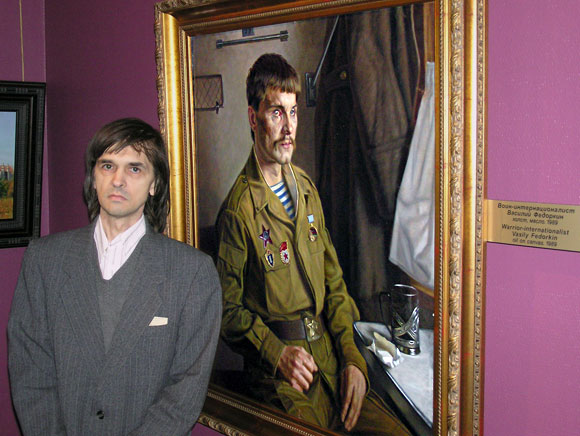
Yaroslaw Rozputnyak and “Warrior Internationalist Vasily Fedorkin” by Alexander Shilov at the Shilov Gallery, Moscow
Russian artists in the USA
by Tina Lindsey, Atlanta, GA, USA
My father, Victor Steele, was a student in Atlanta of the wonderfully gifted and genteel Russian immigrant artists Roman and Constantin Chatov. He tells of their humble and giving spirit, their awesome talent, always eager to assist a student with humor and suggestion, always on the mark. Highly respected, and so embraced by the art community in Atlanta, I can’t imagine how wonderful it would have been had they secretly stolen away and left their mark upon on the walls of hidden places in Atlanta to later be discovered to the delight of its citizenry. Thank you to the Above for the gift of Roman and Constantin Chatov.
Painting while away
by Gloria Ainsworth Mout, Surrey, BC, Canada
Thanks for your provocative and enlightening letters. I recently heard you say that you feel rejuvenated when returning from a trip. Does this mean that you do not paint while you are away? Do you sketch? You obviously take photos as we see them on your web site. In these days of heightened security do you have problems taking your paints and how would you carry them?
(RG note) I’ve not painted while in Russia. No time and too much intimidating stuff on gallery walls. The previous trip to Costa Rica was another sort of travel. I travel with a simple acrylic box, a supply of small canvases and make somewhat cursory quickies which are in tune with my span of concentration at these times. Lots of photos while in Russia of course. I take slides for future reference, prints for fun, and so far, over 700 digitals. I dump 250 at a time on the hard drive of my laptop and email the odd one here and there.
Be ready for the lightning bolt
by Sandra Noble Goss, Owen Sound, ON, Canada
In the 1980s I lived in the country but had a studio in town. I often found the 25 minute drive home at the end of the day a very creative time. Often ideas come totally out of the blue and I would pull over to the side of the road and make a sketch on any piece of paper in the car. I am a jeweler and one of my most successful earring designs “came” to me this way. Almost 20 years later I remember the exact spot on the road. I have often spoken to students about creativity and how to generate jewelry designs. I tell them they should develop strategies for developing designs and ideas, but should always be open and ready for the lightening bolt of inspiration — but not to count on it.
Just walk in
by Janet Vanderhoof, Morgan Hill, CA, USA
I’m currently trying to find an art gallery to show my work for the first time. My coach says you shouldn’t make an appointment, just walk in. He says the most difficult thing to do is to have them look at your portfolio. There are so many artists, that the galleries are not really looking for new artists and almost seem bored at the idea. At first, I thought I could go in there with huge confidence, but chose to take the humility route, asking them politely if they had time take a look at my portfolio. I asked them if they could tell me what they thought of my work. I could see their demeanor change. They were no longer on the defensive. They liked the idea that they could be helpful. Even the galleries that I knew were going to be extremely difficult, actually looked at my work. I also asked them if they had any suggestions on what I could do next. A lot of them spent quite a bit of time with me and were very helpful for leads and networking. They liked my work and that ended up being the best marketing tool.
Contemporary practice in Russia
by Gabriella Morrison
Recently a friend returned from a visit to Russia and had a slide show of places like the Hermitage, the Pushkin Gallery and of public art in the Moscow metro. There was a complete absence of photographs of ordinary life in Russia, and she intimated that photographing the ordinary, therefore interesting, aspects of Russian life was much discouraged by her hosts. It seems to me that here is an official view of what contemporary Russian life is that is promulgated by some not-so-subtle pressures. Much of what passes for official art and architecture is the picturesque that does not threaten the status quo. And it would seem that unofficial ways of traveling are discouraged, and the resulting photographic records of people’s travels are skewed in the direction of fantasy, officially sanctioned. Are there artists in Russia engaged in contemporary practices? And why is this information so difficult to come by?
(RG note) I noticed that, too. Maybe I’m looking in the wrong places, but I see no photographic documentation of, for example, subsistence living conditions in the Russian countryside. Photography that I saw was a type of abstract minimalism. There are lots of safe (and boring) status quo sentimental landscapes in the universal “quickie” style. Regarding “contemporary practice” there is some to be seen here and there — vestigial, I thought. Depending on your point of view, Russia may be slowly opening to Western norms, or being corrupted by them.
Lost in Moscow
by Lili, Russia
From Romania I went to Russia to see a concert and for the joy of traveling. I was a student at that time, a little short of money but had lots of freedom and courage. With no prearrangements, just got in the train and left for Moscow. In the train I met a Russian lady, going home. Something impressed her and she let me stay at her place. She showed me the big city, everything she could show me in 48 hours. Red Square, all types of food, Russians. A concert ended about midnight and I had to take the Metro, to get back to the lady’s place. I was so free and happy and I didn’t need anything, not even the address where I was supposed to get back to. In the middle of everything, I found the right Metro station, with the help of a foreigner but, as you’ve mentioned, all the streets in Moscow look the same. Cyrillic! After some time of wandering around, admiring the city at night, I saw a young couple. I told them I was lost and that I didn’t know where to go. They didn’t speak English well, almost not at all, and I had no idea of Russian language. Just “old, red balsoi house” and a street with K letter. It was funny though. I walked with Slava and Diana for some time and we took the bus. About 2 a.m. we found the street and, after some time, we finally found the house–red and big and old. In 24 hours I was on the train, heading back to Romania.

Two Candles oil painting |
You may be interested to know that artists from every state in the USA, every province in Canada, and at least 105 countries worldwide have visited these pages since January 1, 2005.
That includes Patti Mollema who wrote, “Thank you for broadening my world. I’m a new subscriber, a teacher, one who struggles to find time to do art and to learn more. I need at least one more lifetime for it all but you are helping more than you know.”
And also Ellen Kirk who wrote, “Our guides and interpreters only wanted to talk about the Stalin wedding-cake monster buildings.”
And also Paul Kane who wrote, “As far as I can see, our oh-so-evolved society has no sense of shared human vision anymore, if it ever did have one. Sad. Horrible. The face of totalitarianism turned out to be a mask (obviously), but the face of Capitalism has no face at all.”


